Yokohama Station
YHMJT05JK12JO13JS13 TY21    Yokohama Station 横浜駅 | |
|---|---|
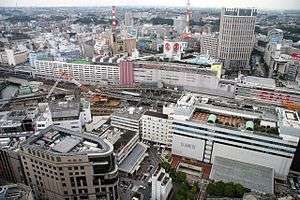 Yokohama Station viewed from above, October 2005 | |
| Location |
1 Takashima (Keikyu) 2 Takashima (JR East) 1 Minami-Saiwai (Tokyu, Sotetsu, Subway) Nishi-ku, Yokohama-shi, Kanagawa-ken Japan |
| Operated by | |
| Connections | Bus terminal |
| History | |
| Opened | 1872 |
| Location | |
 Yokohama Station Location within Kanagawa Prefecture | |
Yokohama Station (横浜駅 Yokohama-eki) is a major interchange railway station in Nishi-ku, Yokohama, Japan. It is the busiest station in Kanagawa Prefecture and the fifth-busiest in the world as of 2013,[1] serving 760 million passengers a year.
Lines
Yokohama Station is served by the following lines:
- East Japan Railway Company (JR East)
- Keikyu
- Sagami Railway (Sotetsu)
- Tokyu Corporation
- Yokohama Minatomirai Railway
- Yokohama Municipal Subway
- Blue Line (B20)
(JR Central's Tokaido Shinkansen passes through Shin-Yokohama Station, not Yokohama Station.)
Station layout
Keikyu and JR East
The JR East and Keikyu platforms are located in the main above-ground portion of Yokohama Station. Keikyu's section consists of platforms 1 to 2, JR East operates platforms 3 to 10.
Tokyu and Minatomirai
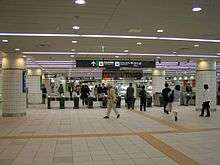
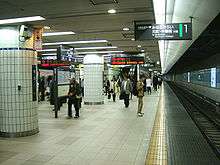
Tokyu Corporation and the Yokohama Minatomirai Railway Company share the same underground station located in the 5th underground level of Yokohama Station, to the west of the JR platforms.
| 1 | ■ Minatomirai Line | for Minatomirai and Motomachi-Chūkagai |
| 2 | TY Tōkyū Tōyoko Line | for Musashi-Kosugi, Jiyūgaoka, Naka-Meguro, and Shibuya F Tokyo Metro Fukutoshin Line for Shinjuku-sanchome, Ikebukuro, Kotake-mukaihara, and Wakoshi Seibu Ikebukuro Line for Hannō TJ Tōbu Tōjō Line for Shinrinkōen |
Yokohama Municipal Subway
The Yokohama Municipal Subway is located on the 3rd basement level, west of the main station.
| 1 | ■ Blue Line | for Sakuragichō, Kannai, Kamiōoka, Shōnandai |
| 2 | ■ Blue Line | for Shin-Yokohama, Center-Kita, and Azamino |
Sotetsu
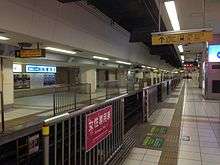
Sagami Railway is an above-ground structure to the west of the main station, connected to the Sotetsu Department Store.
| 1-3 | ■ Sotetsu Main Line | for Futamatagawa, Yamato, Ebina, and Shōnandai |
Adjacent stations
| « | Service | » | ||
|---|---|---|---|---|
| Tōkaidō Line-(via Ueno–Tokyo Line) JT05 | ||||
| Commuter Rapid: Does not stop at this station | ||||
| Ōfuna OFNJT07 |
Odoriko | Kawasaki KWSJT04 | ||
| Odawara Yugawara Atami |
Super View Odoriko | Shinagawa SGWJT03 Tokyo TYOJT01 | ||
| Totsuka TTKJT06 |
Rapid Acty | Kawasaki KWSJT04 | ||
| Totsuka TTKJT06 |
Local | Kawasaki KWSJT04 | ||
| Negishi Line—Keihin-Tōhoku Line/Yokohama Line JK12 | ||||
| Sakuragichō JK11 | Rapid | Higashi-Kanagawa JK13 JH13 | ||
| Sakuragichō JK11 | Local | Higashi-Kanagawa JK13 JH13 | ||
| Yokosuka Line JO13 | ||||
| Totsuka TTKJO10 |
Narita Express | Musashi-Kosugi MKGJO15 | ||
| Hodogaya JO12 | Local | Shin-Kawasaki JO14 | ||
| Shōnan-Shinjuku Line JS13 | ||||
| Atami | Super View Odoriko | Musashi-Kosugi MKGJS15 | ||
| Totsuka TTKJS10 |
Special Rapid | Musashi-Kosugi MKGJS15 | ||
| Totsuka TTKJS10 |
Rapid | Musashi-Kosugi MKGJS15 | ||
| Hodogaya JS12 | Local | Shin-Kawasaki JS14 | ||
| Keikyu Main Line KK37 | ||||
| Keikyu Wing: Does not stop at this station | ||||
| Morning Wing: Does not stop at this station | ||||
| Keikyū Kawasaki KK20 | Limited Express (Kaitoku) | Kamiōoka KK44 | ||
| Kanagawa-shimmachi KK34 | Limited Express (Tokkyū) | Kamiōoka KK44 | ||
| Nakakido KK35 | Airport Express | Hinodechō KK39 | ||
| Kanagawa KK36 | Local | Tobe KK38 | ||
| Sagami Railway Main Line | ||||
| Terminus | Limited Express | Futamatagawa | ||
| Terminus | Express | Futamatagawa | ||
| Terminus | Rapid | Hoshikawa | ||
| Terminus | Local | Hiranumabashi | ||
| Tokyu Toyoko Line TY21 | ||||
| Minatomirai Line (MM01) | ||||
| Jiyūgaoka TY07 | S-Train[Note 1] | Minatomirai (MM03) | ||
| Kikuna TY16 | Limited Express | Minatomirai (MM03) | ||
| Kikuna TY16 | Commuter Express | Minatomirai (MM03) | ||
| Kikuna TY16 | Express | Minatomirai (MM03) | ||
| Tammachi TY20 | Local | Shin-Takashima (MM02) | ||
| Yokohama Municipal Subway Blue Line (B20) | ||||
| Sakuragichō (B18) | Rapid | Shin-Yokohama (B25) | ||
| Takashimachō (B19) | Local | Mitsuzawa-Shimochō (B21) | ||
- Notes
- ↑ Weekends only
Bus services
Expressway bus (daytime)
- Yokohama City Air Terminal[2]
- for Haneda Airport[3]
- for Narita Airport[4]
- Eastside bus terminal
- for Tokyo Disney Resort[5]
- for JR Gotemba Station (Mount Fuji), Hakone Tōgendai (Lake Ashi)[6]
Expressway bus (overnight)
- Yokohama City Air Terminal
- for JR Nagoya Station, JR Okayama Station[7]
- Eastside bus terminal
- for JR Kyoto Station, JR Ōsaka Station, JR Sendai Station, JR Akita Station[7]
Local routes
Surrounding area
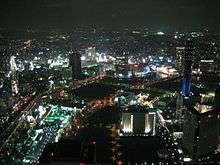
The west and east have a complex underground business district which spans over several floors and is directly connected with the buildings which surround the station. Yokohama station has three bus terminals, and two other bus terminals are located near the station.
East entrance
- Porta (underground shopping mall)
- Sogo (department store, with Yokohama station eastside bus terminal)
- Lumine (shopping building)
- Kiyoken
- Marui (0101) (department store)
- Yokohama Sky Building (with Yokohama City Air Terminal, and its bus terminal)
- Bay Quarter Yokohama (shopping center)
- Yokohama Plaza Hotel
- Yokohama Central Post Office
- The Port Service Yokohama Station East Exit pier
West entrance
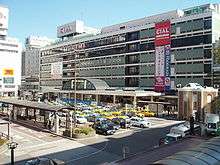
- The Diamond (underground shopping mall, and stairs to westside bus terminal)
- Takashimaya (department store)
- CIAL (shopping building : under construction)
- Sotetsu Joinus (shopping building)
- Sotetsu Movil 109 cinemas
- Yokohama station westside second bus terminal
- Yokohama Cinema Society
- Yokohama Excel Hotel Tokyu (under construction)
- Yokohama Bay Sheraton Hotel and Towers
- Yokohama More's (shopping building, with Tokyu Hands Yokohama store)
- Yodobashi Camera Yokohama store
- Bic Camera Yokohama store
- Vivre (shopping building)
- Daiei (supermarket)
- NTT Yokohama East Building
History
First station
On May 7, 1872 (June 12 in Gregorian calendar), Yokohama Station (original station, now Sakuragichō Station) opened as one of the first railway stations in Japan.
On July 11, 1887, the railway was extended from Yokohama to Kōzu Station. Through trains between Shimbashi Station and Kōzu Station required a switchback at Yokohama Station. On August 1, 1898, a line bypassing Yokohama Station was opened to avoid the switchback. Through trains stopped at Kanagawa Station or Hodogaya Station instead of Yokohama Station, and shuttle trains connected Yokohama and Hodogaya until Hiranuma Station opened near present-day Hiranumabashi Station on October 10, 1901.[12] Hiranuma Station had no connection to public transport such as trams, so that major part of the passengers for the city continued to use trains that stopped at Yokohama Station.[13]
Second station
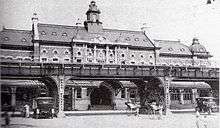
On August 15, 1915, the second Yokohama Station opened close to the present day Takashimachō Station to allow Tōkaidō Main Line trains to call at Yokohama Station. The original Yokohama Station was renamed Sakuragichō Station. JR East uses this date as the opening date of the current Yokohama Station.[14] The terminal of the Keihin Line (present-day Keihin-Tōhoku Line) had been in Takashimachō since 1914 and was merged to the new station. The government-run electric line was later this year extended to Sakuragichō.
On 1 September 1923, the station was destroyed by a fire in the 1923 Great Kantō earthquake. Six days later, the station reopened with a temporary building. The city of Yokohama and the Ministry of Railways agreed in February 1924 that the station would be relocated.[15]
On May 18, 1928, the Tokyo Yokohama Railway (now the Tokyu Toyoko Line) extended from its former terminal of Kanagawa Station was connected to the station. The extension line passed through the construction site of the new Yokohama Station of the government railways.[16]
Third station
.jpg)
On October 15, 1928, the third (current) Yokohama Station opened on the north side of the second station. The Tōkaidō Main Line also moved to its current route, which was the route of the bypass line opened in 1898. The government railways and the Toyoko Line shared the station from the beginning.[17] On February 5, 1930, the Keihin Electric Railway (now the Keikyu Main Line) was connected to the station. On December 27, 1933, the Jinchū Railway (now the Sotetsu Main Line) was connected to the station. On December 9, 1957, the north side underground entrance opened. On December 1, 1965, the MARS on-line ticket reservation system was introduced at the station. On September 4, 1976, the Yokohama City Subway Line No. 3 was connected to Yokohama Station. On November 7, 1980, the new east station building and east-west passage opened. On January 31, 2004, The Tōkyū Tōyoko Line platform reopened underground, and on February 1, 2004, the Minatomirai Line opened.
Future
On August 26, 2010, JR East announced the development of a new station building to replace the current West Entrance, tentatively named the Yokohama Station West Station Building (横浜駅 西口駅ビル Yokohama-eki Nishiguchi-eki biru).[18] Scheduled to open in 2020 before the Tokyo 2020 Summer Olympics, the development will include a 26-story retail and office building, Station-front tower (駅前棟 Ekimae-tō), on the site of the current West Entrance and a nine-story building to the north-east, Tsuruya-cho tower (鶴屋町棟 Tsuruyamachi-tō), which will include parking and childcare facilities.[19]
Passenger statistics
In fiscal 2013, the JR East station was used by an average of 406,594 passengers daily (boarding passengers only), making it the busiest JR East station in Kanagawa Prefecture and the fourth-busiest on the JR East network as a whole.[20]
The JR East passenger figures for previous years are as shown below.
| Fiscal year | Daily average |
|---|---|
| 2000 | 385,023[21] |
| 2005 | 384,594[22] |
| 2010 | 398,052[23] |
| 2011 | 394,900[24] |
| 2012 | 400,655[25] |
| 2013 | 406,594[20] |
See also
References
- ↑ "The 51 Busiest Train Stations in the World". Rocketnews24.com. Retrieved 23 December 2013.
- ↑ Yokohama City Air Terminal index
- ↑ Keikyu Limousine Haneda Airport Express
- ↑ Airport Transport Service
- ↑ Keikyu Bus TDR Line Archived October 23, 2013, at the Wayback Machine. (in Japanese)
- ↑ Keikyu Bus Hakone Tōgendai Line
- 1 2 JR Bus Group (in Japanese)
- ↑ Transportation Bureau, City of Yokohama
- ↑ Sotetsu Bus Information (in Japanese)
- ↑ Kanachu Bus Information (in Japanese)
- ↑ Keikyu Bus Route Information Archived October 23, 2013, at the Wayback Machine. (in Japanese)
- ↑ Ishino, Tetsu et al. (eds.) (1998). 停車場変遷大事典 国鉄・JR編 [Station Transition Directory - JNR/JR] (in Japanese). II. Tokyo: JTB Corporation. p. 13. ISBN 4533029809.
- ↑ 「地図」で探る横浜の鉄道 [Explore Railways in Yokohama with Maps] (in Japanese). Museum of Yokohama Urban History. 2011. p. 20. ISBN 978-4-9905683-0-6.
- ↑ "JR東日本:各駅情報(横浜駅)" (in Japanese). Retrieved August 16, 2013.
- ↑ 「地図」で探る横浜の鉄道 [Explore Railways in Yokohama with Maps] (in Japanese). Museum of Yokohama Urban History. 2011. p. 64. ISBN 978-4-9905683-0-6.
- ↑ Yamada, Akira. 横浜・川崎の鉄道 [Railways of Yokohama and Kawasaki]. The Railway Pictorial (in Japanese). Denkisha Kenkyūkai Tetsudōtosho Kankōkai. 875 (May 2013): 14.
- ↑ Tōkyō Kyūkō Dentetsu, ed. (1943). 東京横浜電鉄沿革史 [History of Tokyo Yokohama Electric Railway] (in Japanese). p. 533.
- ↑ "Commencement of Environmental Impact Assessment Procedures for the Yokohama Station West Exit Station Building Plan (Tentative Name)". East Japan Railway Company.
- ↑ "Yokohama Station West Exit Building Plan (Tentative Name)" (PDF). East Japan Railway Company. Retrieved 27 September 2015.
- 1 2 各駅の乗車人員 (2013年度) [Station passenger figures (Fiscal 2013)] (in Japanese). Japan: East Japan Railway Company. Archived from the original on 2001-05-06. Retrieved 31 August 2014.
- ↑ 各駅の乗車人員 (2000年度) [Station passenger figures (Fiscal 2000)] (in Japanese). Japan: East Japan Railway Company. Retrieved 19 October 2013.
- ↑ 各駅の乗車人員 (2005年度) [Station passenger figures (Fiscal 2005)] (in Japanese). Japan: East Japan Railway Company. Retrieved 19 October 2013.
- ↑ 各駅の乗車人員 (2010年度) [Station passenger figures (Fiscal 2010)] (in Japanese). Japan: East Japan Railway Company. Retrieved 19 October 2013.
- ↑ 各駅の乗車人員 (2011年度) [Station passenger figures (Fiscal 2011)] (in Japanese). Japan: East Japan Railway Company. Retrieved 19 October 2013.
- ↑ 各駅の乗車人員 (2012年度) [Station passenger figures (Fiscal 2012)] (in Japanese). Japan: East Japan Railway Company. Archived from the original on 2014-10-07. Retrieved 31 August 2014.
External links
| Wikimedia Commons has media related to Yokohama Station. |
- JR-East Yokohama Station information
- Keikyu Railway Train and Bus information
- Tokyu Railway information
- Yokohama Minatomirai railway information
- Sōtetsu Line Yokohama Station Map
- Transportation Bureau, City of Yokohama (Municipal Subway and Bus)
Coordinates: 35°27′55.60″N 139°37′22.21″E / 35.4654444°N 139.6228361°E